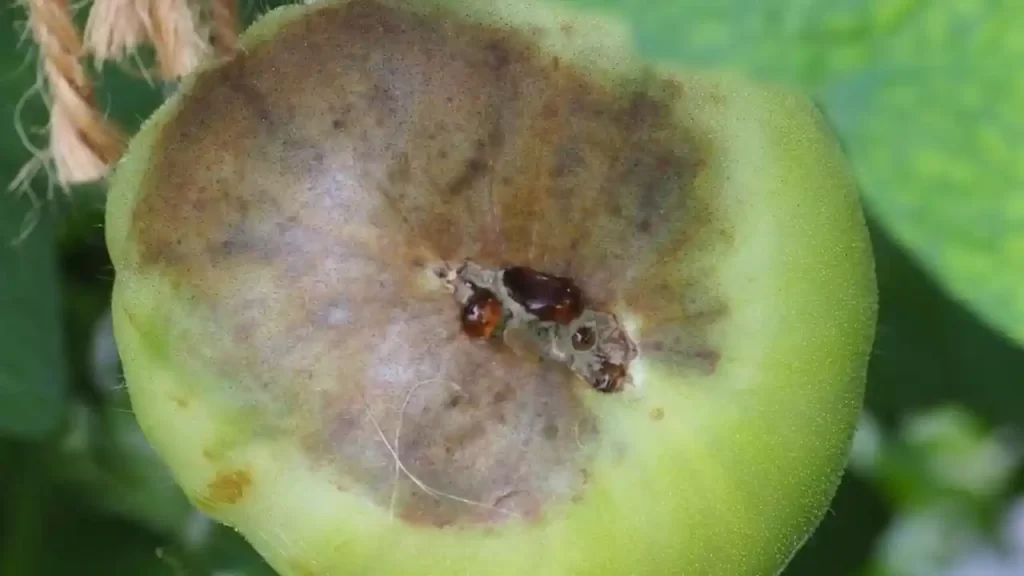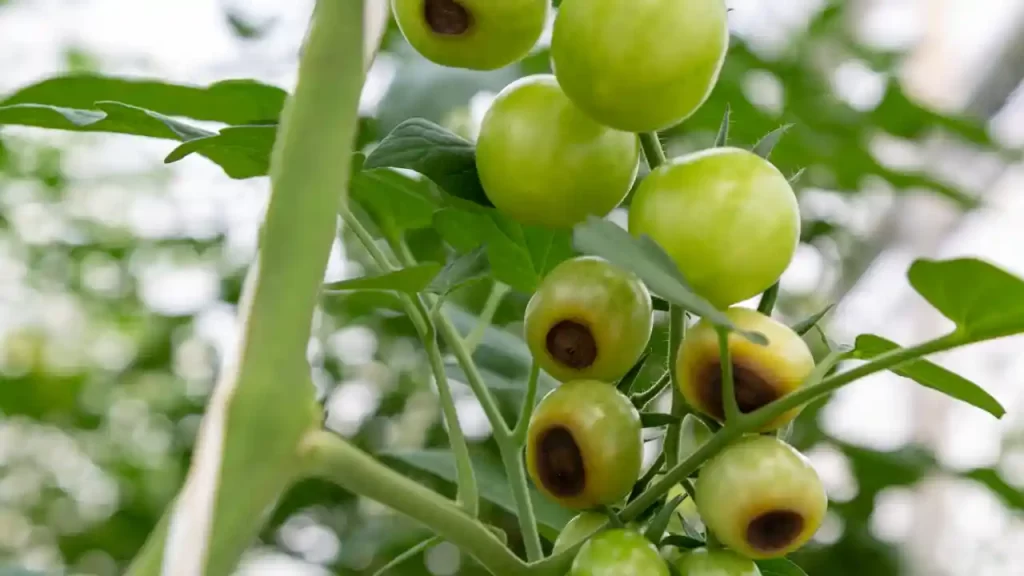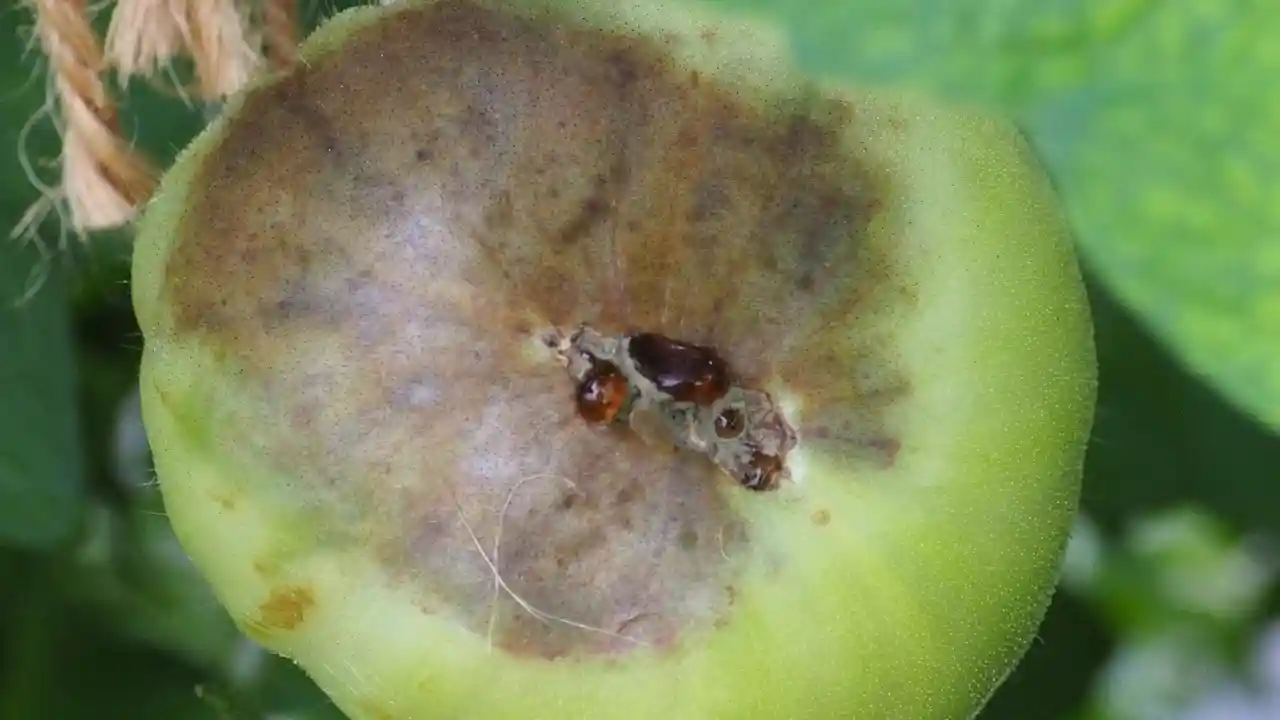No gardener loves to see their tomatoes rotting. It really demotivates them to cultivate tomatoes when they get rotten tomatoes after a lot of hard work. When your tomatoes turn brown and leathery, it has started rotting and needs much care and attention.
What causes bottom rot on tomatoes? Mainly Blossom End Rot occurs due to a lack of calcium. You can prevent it by giving sufficient calcium to plants. But at the same time, you must be extra cautious about other factors.
I have covered all these points broadly in this article.
What Is Blossom-End Rot?

Blossom End Rot is a situation when the plant gets calcium deficiency. This results in the breakage of the tomato’s cell walls, and rotten spots are identified in the bottom part of the fruits. The affected areas become dark brown or sometimes black.
The blossom end rot occurs mainly at maturity or in the first tomato growing season.
Symptoms of Blossom End Rot
To avoid blossom end rot, you must identify the symptoms that leads to rotting. Here are some of the blossom end rot symptoms that you can easily identify: (1)
- Watersoaked spot at blossom end.
- The spot color changes from brown to black.
- Soft rotting of fruits doesn’t occur.
- Affected fruits ripen earlier than healthy fruits.
What Causes Tomato Blossom End Rot ?

Lack of calcium is the leading cause of Blossom End Rot. Mainly its effect is visible when tomato fruits reach maturity.
This type of rot does not happen because of any fungal infection or virus attack on the plant. So don’t even think of using pest controllers to cure this issue.
Here are some of the reasons for Blossom End Rotting:
- Moisture – Too little or too much- Your soil might be too dry because of excessive heat or underwatering, or it may be too wet and becomes soggy because of overwatering. Ensure to maintain the correct moisture level in the soil.
- Too much Nitrogen- Calcium deficiency also arises with the overuse of nitrogen. Opting for fresh manure and compost is the best, and you can get a good amount of fresh and quality tomatoes.
- Soil is too cold- Tomato is a warm-loving plant. If the soil is too cold, the roots become inefficient in delivering proper nutrients to the plant. You can use heat maps to overcome the issue.
- Root damage due to cultivation- Avoid aggressive digging in nearby areas of tomato plants as it can cause damage to roots and adequate nutrients are not delivered to the plants.
- Too high or too low Soil pH– Soil pH level should be within limits, or it could be the reason for Blossom End Rot.
Are you tomatoes splitting? If yes, check our blog on “Why Do Tomatoes Split And How To Prevent This“?
How To Fix Blossom End Rot?

When you see black, spotty and brown tomatoes, you should understand that you can’t save those tomatoes. Unfortunately, there is no treatment for the affected fruit.
But you can use my prevention and control strategy to save the rest of your tomatoes from getting affected with Blossom End Rot.
Maintain steady levels of moisture in your plants:
Maintaining a steady moisture level in the soil is very important. Using a straw helps suck the moisture from soil when it is too moist.
You can use water cones or this Soaker Hose for steady supply of water to the plant.
Potted tomatoes mostly face lack of sufficient moistness and produce Blossom Rot. You can use REMIAWY Plant Watering Stakes for in containers tomato plants. Remiawy is a terracotta watering spikes that work through osmosis.
Use Organic Fertilizers:
Using fresh manure and compost is always appreciated. The manure of rabbits and hamsters is rich for tomato plant growth.
I use Malibu Compost for my tomatoes, which increases my plant’s immune system and restores the soil nutrients.
Don’t Use Too much fertilizer
Too much and frequent use of fertilizers can damage your plant and reduce the garden soils nutrition. Its overutilization promotes the fast growth of the plant.
Much of the plant’s calcium is used during the growing stage, and plants go through calcium deficiency at the stage of producing fruits, ultimately Blossom End Rot appears.
Using a rich soil mix of fresh manure and compost is always best and promotes the healthy growth of your plant.
Always do a soil test before using fertilizers, and never forget to read the labeled instructions before use.
There are times when your tomato may not turn red or ripe, check our helpful gardners blog on Why do tomatoes not ripen or turn red?
Maintain soil Temperature:
Tomatoes can neither be grown in too hot nor in too cold soil. They grow healthy and fast in warm soil. The ideal soil temperature for tomatoes is 15-18 degree Celsius. You can use a soil thermometer to check soil temperature.
Heat mats are the best option to maintain warmth or increase the soil temperature. The use of red or black plastics also promotes soil heat. You can also use organic mulch in case of excessive soil temperature.
Don’t Work on Ground Close to the Plant:
Don’t dig or work around the area too close to your tomato plants. You can remove weeds gently when needed, but don’t harm your plants.
Mulching around your plant is the best way to protect them from blossom end rot.
Check Soil pH and Correct as Needed:
The ideal pH level of soil for tomato cultivation is 6.2 – 6.8. A spray of calcium helps to enhance the PH level of the soil.
Organic mulches and compost help reduce soil’s pH level when it reaches the maximum. You can use Soil pH meters to check the pH level.
Use a Tomato Fertilizer with Calcium:
Calcium spray and antacid tablets helps enhance the soil quality, which is vital in growing good-quality tomatoes.
You can also Espoma GL6 Garden Lime Soil Amendment to meet the calcium deficiency for your plant. Always read labeled instructions before using.
Plant Tomato Varieties That Are less Susceptible To Blossom End Rot
While growing tomatoes, it has been noticed that some varieties are more prone to Blossom End Rot, whereas others face less Blossom End Rot.
Let us look at the table for more information.
| Varieties of tomatoes with less than 10 percent Blossom End Rot | Varieties of tomatoes with almost 15 to 30 percent Blossom End Rot |
| Celebrity | Big Boy |
| Fresh Pack | Castle King |
| Jet Star | Fantastic |
| Manapal | Independence |
| Mountain Pride | Supersonic |
| Pik Red | Surprise |
| Sunny | Whopper |
| Winter | Wonder Boy |
Can overwatering cause blossom end rot?
Overwatering and underwatering both cause danger for the plants and result in Blossom End Rotting. Limited watering helps to maintain consistent soil moisture.
Follow the above discussed tips to keep your soil sufficiently moist.
Why are my tomatoes rotting on the bottom?
Tomato plants necessitate calcium in every growing part, from the roots to their fruits. Unfortunately, a lack of calcium and water may lead to a deficiency and cause this tomato rot – also known as bottom rot.
Inadequate hydration impedes the plant’s capacity to transport its required calcium levels throughout itself.(2)
Summary
We all know that prevention is better than cure. So be careful and follow the tips discussed above when planting your tomatoes, and you will never face Blossom End Rotting. Instead, you would be rewarded with fresh, quality tomatoes.
